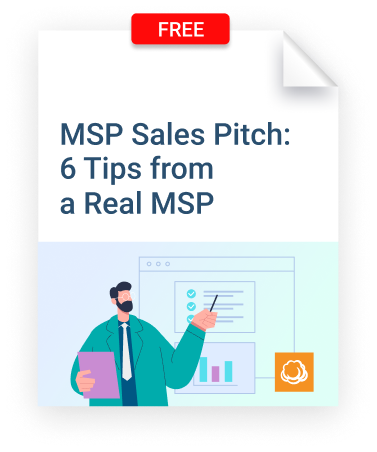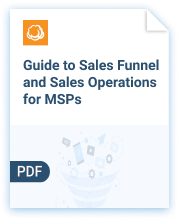MSP Business
The Comprehensive Guide to MSP Sales
Running a sales operation may not be the most exciting part of your work as an MSP. But the fact is that, for an MSP business to be successful it needs an effective sales plan, sales team, and strategy for tracking sales performance.
Keep reading for tips on how to implement each of these things for your MSP business, along with links to further reading with additional details on each topic.
Create a Customer Profile
You can’t sell effectively if you don’t know who your customers are. That’s why building a profile of your target customer is a crucial first step in developing an MSP sales strategy.
To be clear, when we say you should build a customer profile, we mean that you should identify the key characteristics of the customers to whom you will ideally sell. This is different from acquiring customers first, then figuring out what their profiles are. If you start by determining what your ideal customer looks like, you can target those types of customers with your MSP sales operation.
This makes for a much more effective strategy than simply casting a wide net and seeing which customers respond. If you take that approach, you may end up spending sales resources on leads who are not a good fit for your company (based on their technical needs, budget, and so on). Worse, you could end up with customers whom you can’t really support.

So, start off your MSP sales strategy by building a profile of the customers whom you are well-positioned to serve. Be sure that your profile identifies the following:
The Size of the Customer’s Company
How many employees does your ideal customer have? How many devices exist within the customer’s IT infrastructure? What amount of budget should the customer have to spend on managed IT services? These are all important questions to answer to ensure that you don’t bite off more than you can chew, while at the same time keeping your business profitable.
Industry
Which industry or industries do you want to provide services for? Many MSPs specialize in certain verticals, such as healthcare or finance.
Further reading 5 Tips for Choosing Your Vertical
Pain Points
What, specifically, does your customer need from an MSP? The answer to this question includes which types of managed services the company is looking for, as well as the level of support and guidance that it requires. Some customers are looking only for specific services, like data backup or server management, while others need big-picture guidance for their overall IT strategy.
Further reading Top 5 SMB Pain Points Solved by MSPs
Who Are the Decision-Makers?
Who do you need to reach your target customer’s company in order to market yourself and close a deal? For smaller companies, the decision-maker is often a CTO or (for smaller companies) even a CEO. At larger clients, the decision-makers for a managed services contract will be mid-level management.
Once you’ve answered all of these questions, you can create a customer profile, and design sales operations that target that portfolio.
MSP Sales Funnel
Once you know who your customers are, you’re ready to begin MSP sales operations. The best way to do this is to adhere to the tried-and-true sales process, which includes the following steps:
- Lead generation, during which the MSP generates awareness and interest among potential customers in the MSP’s services.
- Qualifying of prospects, meaning that the MSP engages with leads via phone conversations or email to confirm that they are good potential customers.
- Proposal of services to provide to qualified prospects.
- The closing of the deal.
- Follow-up and loyalty programs to motivate contract renewals or increased business.
This process is sometimes represented visually as a sales funnel. For more on these steps, check out our guide to MSP sales operations.
Further reading MSP Sales Cadence: Key Things to Learn


Measuring MSP Sales Metrics
Sustaining a successful MSP sales operation requires monitoring and measuring it in order to track performance, identify weak points, and find ways to achieve continuous improvement.
The most common MSP sales metrics to track include:
- Median Recurring Revenue, or your average revenue in a given period.
- Average Deal Size, or the average value of the contracts you sign.
- Time to close, which refers to how long it takes you to close a deal, on average.
For more insight on these and other metrics that can help you measure your sales performance, see our article on MSP sales metrics.
Further reading Guide to MSP Sales Critical Metrics
Managing an MSP Sales Team
At first, you might rely on yourself and your technical staff to run sales operations. But as your MSP business grows, you’ll need to hire and manage dedicated sales personnel.
Finding and managing the right salespeople for your business is no easy task, especially for MSPs who specialize in technical services, not sales and sales management. But as long as you ensure that you post clear job ads, set MSP sales compensation plans properly, and document your sales process effectively, your sales team is easier to manage than you might expect.
For tips on these processes, see our guide on building and managing an MSP sales team.
Conclusion
As an MSP, your specialty is providing managed IT services. But running a business is also critical if you want to succeed as an MSP, and that requires a systematic approach to building and managing MSP sales operations. The processes and resources described above will help you get started with this complex but essential part of running an MSP business.



